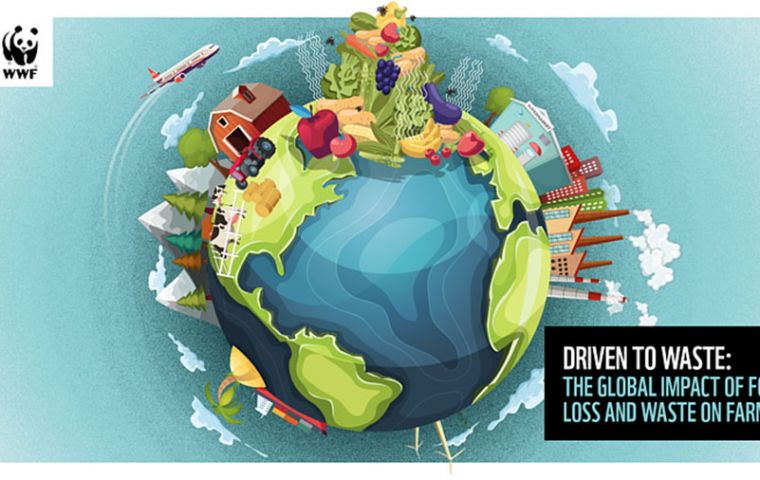MercoPress. South Atlantic News Agency
Some 2,5 billion tons of food goes to waste, WWF
 Driven to Waste is the first quantification of total on-farm food losses since 2011
Driven to Waste is the first quantification of total on-farm food losses since 2011 WWF and Tesco released Driven to Waste, a new report that quantifies the total amount of food lost on farms globally; revealing an estimated 2.5 billion tons of food goes uneaten around the world each year.
That is an increase of approximately 1.2 billion tons on the established estimates of 1.3 billion tons wasted each year. These new estimates indicate that of all the food grown, approximately 40% goes uneaten, which is higher than the previously estimated figure of 33% .
Driven to Waste is the first quantification of total on-farm food losses since 2011. When combined with updated data on loss in supply chains and waste at retail and consumption, we have a clearer picture of the scale of food loss and waste from farm to fork that demonstrates for the first time how imperative it is that this stage is no longer overlooked in efforts to keep global warming below 1.5 degrees Celsius.
Producing food uses a huge amount of land, water and energy, so wasted food significantly impacts climate change – previous estimates suggest that food waste accounts for 8% of greenhouse gases (GHG). Driven to Waste’s new data indicate that the numbers are even more substantial, pointing to a contribution of approximately 10% of all GHG emissions. This is the equivalent of nearly twice the annual emissions produced by all the cars driven in the US and Europe.
Compounding the pressure from continued global agricultural resource-use expansion, 4.4 million km2 of agricultural land and 760km3 of water are used to produce the 1.2 billion tons of food that are lost before, during and after harvest or diverted to other uses such as animal feed and bio-fuel. This equates to a landmass larger than the Indian subcontinent and water volume equivalent to 304 million Olympic swimming pools - and this does not include the additional resources used to produce food that is wasted further down the supply chain.
Crucially, in exploring the contributory factors to food loss, Driven to Waste overturns a long-held belief that food loss on farms is solely an issue in less affluent regions with lower levels of industrialization. The report shows that per capita farm-stage losses are generally higher in industrialized regions. Despite having higher on-farm mechanization and only 37% of the global population, high- and middle- income countries of Europe, North America and Industrialized Asia contribute 58% of global harvest waste.
“We have known for years that food loss and waste is a huge problem that can be minimized, which in turn could reduce the impact of food systems on nature and climate. This report shows us the problem is likely bigger than we had thought,” said Pete Pearson, Global Food Loss and Waste Initiative Lead, WWF. “Over 50% of food that goes uneaten is lost on farms, but this is not just an issue in developing regions. Driven to Waste shows us more food is lost on farms per capita in very advanced supply chains like the US and Europe. Food loss and waste, and on-farm food loss, is a global problem.”
Driven to Waste is based on the indicative estimate of the 1.2 billion tons of food loss on farms, the 931 million tons wasted in retail, food service and consumer homes, and calculations to estimate losses occurring in the post farm-gate transport, storage, manufacturing and processing stages.
To calculate estimated losses occurring in the post farm-gate transport, storage, manufacturing and processing stages, the farm stage losses from the Driven to Waste research (1.2 billion tons) were split into the post-harvest losses and in field losses and then, using the percentage of post-harvest losses on farm and in the supply chain provided in the FAO State of Food & Agriculture report (2019), post-harvest losses on farm were subtracted from FAO 2019’s estimate of post-harvest losses up to but not including retail. These figures were derived from the appropriate FAOSTAT production numbers. This created an estimate of 436 million tons for losses occurring in the post farm-gate transport, storage, manufacturing and processing stages. This figure will vary depending on calculation method and assumptions made.




Top Comments
Disclaimer & comment rulesCommenting for this story is now closed.
If you have a Facebook account, become a fan and comment on our Facebook Page!